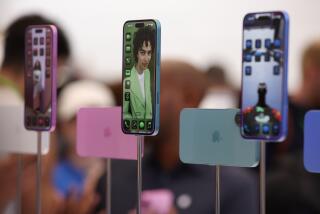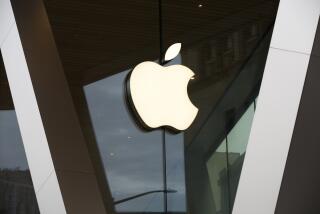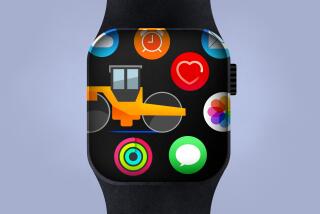Apple aims to show critics it hasn’t lost its innovative edge
SAN FRANCISCO — Apple Inc. unveiled a daring overhaul of its mobile operating system to kick off its annual developers conference, where it hopes to show critics that it has lost none of its innovative swagger.
In addition to unveiling iOS 7, the company made a blizzard of other product and feature announcements that included upgrades to MacBook laptops and a new streaming radio service. As expected, there were no new iPhones or iPads, which are often announced separately.
But the presentation seemed in spirit to also be a rebuttal to critics who contended that Apple had lost its innovative edge in the last year. Along with iOS 7, the weeklong conference here is just as likely to be remembered for Apple Senior Vice President Phil Schiller’s lively jab at critics about the company’s supposed lack of innovation after giving attendees a peek at a new Mac Pro with a cylindrical design.
The effect of anything announced Monday won’t be known for months. The company said most of the new hardware and software products wouldn’t be available until this fall or later in the year. After initially pushing the stock price up during the keynote speech, investors ultimately drove it down $2.92, or less than 1%, to $438.89.
The investors’ reaction may be partly because the iTunes Radio streaming service introduced Monday (but not available until the fall) seemed less consequential than much of the hype it had received in recent weeks as Apple worked furiously to close deals with music labels before the conference. The company revealed iTunes Radio toward the end of the keynote amid a long list of new features for iOS 7, rather than trumpeting it as a radical new music service designed to tackle competitors like Pandora and Spotify.
The service will enable users to create free, ad-based radio stations, similar to Pandora, designed to help them discover new music with the apparent intent to drive the purchase of more digital downloads.
James McQuivey, a Forrester Research analyst, said there may have simply been unrealistic public expectations that anything Apple did related to music would be big.
“There’s not a lot left in the music experience that you can really revolutionize,” McQuivey said. “But maybe because it’s Apple, we just assumed that once they set their mind to it, they would do something that changes the game. As it turns out, this didn’t.”
Still, there was plenty that did seem to galvanize the 5,000 developers in attendance this week, a crowd inclined to be dazzled by all things Apple. They burst into applause when lights dimmed. And new announcements were often met with big cheers or oohs and ahs.
It was this important constituency that Apple Chief Executive Tim Cook seemed intent on addressing by starting the keynote with a kind of methodical stump speech. He rattled off a list of statistics to make his case that Apple’s mobile platform is a far better deal for developers than Google’s Android, even if the latter is used on many more phones now.
Cook noted, for instance, that Apple has paid $10 billion to developers since the App Store opened five years ago, half of that in just the last year. He claimed that amount was more than three times as much as all other mobile platforms combined. And Cook said the 575 million accounts at the App Store were more than any other store on the Internet.
“This is a developers conference,” said Colin Gillis, a research analyst at BGC Partners. “And if you are a developer, you want to be able to eat and pay your rent. It’s clear that Apple is the place to go to monetize your apps.”
The company then ran through a long list of announcements, including new MacBook Air laptops with an astonishing nine-to-12-hour battery life. And it revealed the new version of its Mac operating system, Mac OS X Mavericks, departing from its recent history of naming Mac operating systems after large cats. Mavericks will continue a trend of building in more features available on iOS, such as better cloud-based services.
But the centerpiece of the day was iOS 7, the first version since Cook put Apple’s hardware design guru Jonathan Ive in charge of the look and feel of software last year.
As expected, the new design comes with a new color palette of bright, pastel shades. App buttons are translucent, as are some other features. The company ditched digital effects like leather casing on address books and calendars and green felt on its gaming center in favor of bright bubbles and simpler, fresher looks.
“It’s the biggest change to iOS since the introduction of iPhone,” Cook said.
Just as important to developers, though, was probably a host of new ways they can integrate their apps into Apple services such as maps, Siri and new forms of multi-tasking that will be available.
After the keynote speech, Rob Rhyne, chief executive of app development company Martian Craft, said he was already huddling with his team to figure out how to take advantage of all the new design and feature goodies Apple had thrown their way.
“My overall feeling is, ‘Wow,’ Rhyne said. “It seemed like they’d been quiet for the last six months and today they came out with guns blazing. You just saw Apple at its best.”
O’Brien reported from San Francisco and Rodriguez from Los Angeles.
More to Read
Inside the business of entertainment
The Wide Shot brings you news, analysis and insights on everything from streaming wars to production — and what it all means for the future.
You may occasionally receive promotional content from the Los Angeles Times.












